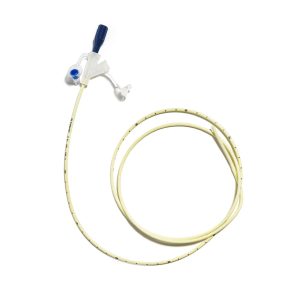A feeding tube, also known as a gastrostomy tube or G-tube, is a medical device used to provide nutrition to individuals who are unable to eat or swallow food normally. It is a flexible tube that is inserted through the abdomen and into the stomach, allowing for the delivery of liquid nutrition directly into the digestive system.
Feeding tubes are typically used for individuals who are unable to consume food orally due to a variety of medical conditions, such as neurological disorders, head and neck injuries, cancer, or other medical conditions that affect the ability to eat and swallow normally. These individuals may require long-term nutritional support, and a feeding tube can be an effective way to provide them with the nutrients they need to maintain their health.
There are several types of feeding tubes available, including nasogastric tubes (NG-tubes), gastrostomy tubes (G-tubes), and jejunostomy tubes (J-tubes). NG-tubes are inserted through the nose and into the stomach, while G-tubes and J-tubes are inserted directly into the stomach or small intestine through a small incision in the abdomen.
The type of feeding tube used will depend on the individual’s specific medical needs and the duration of feeding required. For individuals who require long-term nutritional support, a G-tube or J-tube may be the most appropriate option.
Feeding tubes can be temporary or permanent, depending on the individual’s medical condition. Temporary feeding tubes are typically used for short-term nutritional support, such as during recovery from surgery or illness. Permanent feeding tubes are used for individuals who require long-term nutritional support due to a chronic medical condition.
The placement of a feeding tube is typically performed by a healthcare professional, such as a physician or a specially trained nurse. The procedure is typically performed under local anesthesia and takes about 30 minutes to complete.
Once the feeding tube is in place, it will be connected to a bag or pump that contains the liquid nutrition. The amount and type of nutrition delivered will be determined by the individual’s specific nutritional needs and medical condition.
Feeding tubes require ongoing care and maintenance to ensure they function properly and reduce the risk of infection. Caregivers and healthcare professionals will provide instruction on how to care for the feeding tube and how to administer the liquid nutrition.
While feeding tubes can be an effective way to provide nutrition to individuals who are unable to eat or swallow normally, they can also have potential complications. These can include infection, blockage of the feeding tube, and dislodgment of the tube. It is important for caregivers and healthcare professionals to closely monitor the individual’s condition and take appropriate measures to prevent complications.
In conclusion, feeding tubes are a medical device used to provide nutrition to individuals who are unable to eat or swallow normally due to a variety of medical conditions. There are several types of feeding tubes available, and the type used will depend on the individual’s specific medical needs and the duration of feeding required. While feeding tubes can be an effective way to provide nutrition, they require ongoing care and maintenance to prevent potential complications. Caregivers and healthcare professionals play a crucial role in ensuring the proper care and maintenance of feeding tubes for individuals who require them.



